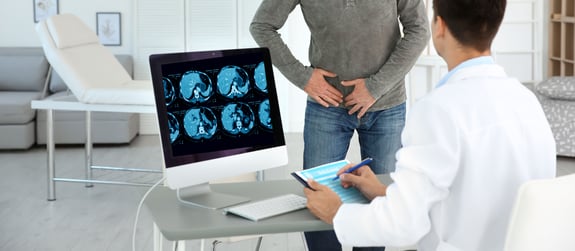
HERNIA Facts
Reviewed By: Dr. Michael Sawyer
SECTION IMAGE BOXES - TITLE
Description. Lorem ipsum dolor sit amet, consetetur sadipscing elitr, sed diam nonumy eirmod tempor invidunt ut labore et
Box Description
What is a hernia?
A hernia is a defect or hole that occurs over time when fatty tissue or an organ bulges out
through an opening in the tissue.
Occurs between chest and abdomen.
Between sternum & belly button.
Occurs at or near the belly button.
The location varies
as it occurs
at the site
of a previous
surgical incision.
Commonly referred to as a groin hernia and can occur on the right or left side; and possibly
even both at the same time.
Appears in the upper thigh or groin area and can occur on the right or left side; and possible
even both at the same time.
Hernia comes
back in the
same location.
General term used to describe a hernia occurring on the front of the abdomen.
Also referred to as a lateral hernia, occurs near the oblique muscles.
Where the hernia tissue or organ becomes trapped in the hernia and can’t be manipulated back
in.
When the blood supply to an organ is cut off because of an incarcerated hernia. This is a
medical emergency and requires immediate attention.
What causes a hernia?
In the simplest terms, a hernia occurs from a combination of two factors: increased internal pressure, such as straining, coughing or lifting and a weakness in the tissues of that abdominal wall (fascia).
Hernias are often complicated by a variety of factors which may include any combination of the following:
- Smoking
- Previous surgery
- Diabetes
- Immune response
- Obesity
- Strenuous exercise such as heavy lifting
- Constipation
- Age
- Genetics
- Congenital defects occurring at birth
- Steroid use
- Concurrent infection

Hernia Symptoms
Box Description
Am I at risk for a hernia?
Males and females are both at risk for developing a hernia, although anatomical differences play a role in how likely you are to develop a hernia.
Due to the extra tissue and space around the male reproductive organs, there's more area for a hernia to occur. As a result, approximately 1 in 4 (or 25%) of males are at risk for developing an inguinal hernia.1
Due to the shape of the female’s pelvis and the deeper location of the reproductive organs, women are more likely to present without a visible bulge. Females are more at risk for umbilical and incisional hernias due to the abdominal wall stretching during pregnancy.2
What can be mistaken for a hernia?
Statistics estimate that 15 out every 1000 people in the US will be diagnosed with a hernia,3 and over 1 million are surgically repaired each year.4 While relatively common, there remains a chance a healthcare provider may fail to diagnose the hernia as the following conditions can mimic hernia symptoms:
- GERD – gastroesophageal reflux disease
- Diastasis recti – separation of abdominal muscles, which in some cases can be repaired without surgery. Diastasis recti is a condition that can happen in
pregnant and postpartum people (when the rectus abdominis muscles separate due to stretch). - Athletic pubalgia – also known as a sports hernia
- Endometriosis, ovarian cysts, or fibroids - in women these conditions can cause pelvic pain

Diagnosing a Hernia
Hernias can only be diagnosed by a licensed healthcare provider during a visual inspection and a physical exam.
Hernia diagnosis based on physical exam can be confirmed by a provider-ordered imaging diagnostic test such as ultrasound, CT scan, or MRI.
Can a hernia be diagnosed via telehealth? Not exactly, but there are healthcare providers who offer telehealth visits and can work with you on a diagnosis game plan.

References:
1. Jenkins JT, O'Dwyer PJ. Inguinal hernias. BMJ. 2008;336(7638):269-272. doi:10.1136/bmj.39450.428275.AD
2. Nouh, T., Ali, F.S., Krause, K.J. et al. Ventral hernia recurrence in women of childbearing age: a systematic review and meta-analysis. Hernia 22, 1067–1075 (2018). https://doi.org/10.1007/s10029-018-1821-1
3. Dabbas N, Adams K, Pearson K, Royle G. Frequency of abdominal wall hernias: is classical teaching out of date?. JRSM Short Rep. 2011;2(1):5. Published 2011 Jan 19. doi:10.1258/shorts.2010.010071
4. Retrieved from https://www.fda.gov/medical-devices/implants-and-prosthetics/hernia-surgical-mesh-implants

